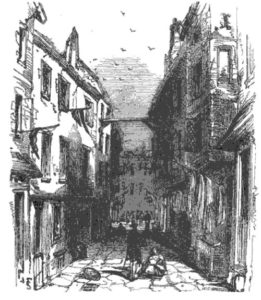
Entire families crammed into single rooms with little to no ventilation because windows were taxed, so they were removed or boarded up. Since candles were expensive, many of these families lived in perpetual darkness. The ancient structures provided no easy access to water, leaving residents to carry their water from the Thames, which was so polluted by nearby cesspits and the filth that dripped through grates and by dumping into the river, that in the summer time, the stench drove most of the upper classes to the country.
Rookeries seldom provided ways to remove waste, so open sewers ran down the streets and mingled with mud. Animal dung and rotting carcasses alleys streets filled with almost-naked children and women wearing used, faded and ill-fitting clothes. Many Irish laborers, whose strong backs helped build so many London fortunes, lived in these rookeries and trudged to work daily to eke out enough to pay the rent but practically starving.
Such cheap and neglected places became breeding grounds for crime, prostitution, addiction, and all manner of filth. In some cases, newer but cheaply-made buildings were constructed between existing structures, cramming in more and more living space and creating tiny alleys where thieves prayed upon those foolish enough to venture there. It was reportedly so dangerous that attempts by the police to perform arrests often resulted in deadly violence. For about 100 years, the police simply avoided those places and advised citizens to do the same.

Thomas Beames, a clergyman, witnessed the unspeakable living conditions and poverty and wrote a report about it called The Rookeries of London: Past, Present, and Prospective published in 1852. He recorded: “A dirtier or more wretched place he had never seen. The street was very narrow and muddy, and the air was impregnated with filthy odours.”
I’m certain such a crowded, dark, filthy living conditions was also a breeding ground for disease, and with no means to pay for medical attention.
The dire living conditions at these dens of vice and poverty were so infamous that in 1816, a Parliamentary Committee was organized to access the London slums and seek solutions. Still, change took decades, partly because so many people had the attitude that these slums were the direct result of wickedness or idleness. They often derided the Irish laborers who lived there. Finally, journalists, novelists and social reformers convinced Parliament that the slums were largely caused by unemployment, under-employment, and little to no access to education.
Finally, the Victorians, in their pursuit for modernization and therefore sanitation, rid themselves of the rookeries and the last remnants of medieval London. As planned, those who inhabited the rookeries left. However, still in need of cheap housing, they relocated to Bermondsey, Brixton and Hackney where they continued to plague Victorians.
In my novel, The Suspect’s Daughter, a couple of scenes that take place in the slums of London, where the heroine, a gently-bred lady, is so horrified by the appalling conditions that she offers the young mother a job at her country home where the woman can better provide for her small children and where they will be safe. Though my heroine can’t help everyone, she helps those she can. It is a philosophy I embrace and that I hope resonates with my readers.
Sources:
http://georgianlondon.com/post/49461306842/slum-living-londons-rookeries
18th and 19th century London Rookeries Historical Hussies
Victorian London – Publications – Social Investigation/Journalism – The Rookeries of London, by Thomas Beames, 1852
London Rookeries posted first on http://donnahatchnovels.tumblr.com/

No comments:
Post a Comment